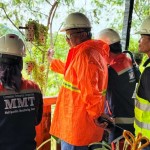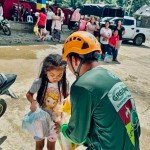Over 100,000 trees planted under TVIRD reforestation program
Jay Nelson is a dead ringer for “Max Headroom”, a popular mid-`80s TV series on a fictional artificial intelligence known for his surreal wit and stuttering, electronically sampled voice. Nelson doesn’t mind the comparisons with the futuristic Max. After all, Nelson’s job as vice president for Environment and Civil Works at TVI Resource Development Philippines, Inc. (TVIRD) also has a lot to do with the future, that is, of the environment in the remote mountains of Southern Philippines where his company extracts minerals. And he is bent on making that future good – with real intelligence and plenty of hard work. (For Max Headroom fans, see photo at the end of the story)
After nearly four years of operations had been completed and with another six years of operations anticipated, TVIRD, spearheaded by Nelson, has been busy implementing the Final Mine Rehabilitation and Decommissioning Plan (FMRDP) for the Canatuan Project in Siocon, Zamboanga del Norte. Progressive Rehabilitation activities have been continuing since mid-2004, when TVIRD began its Gossan (gold-silver) operations, the first phase of the Canatuan Project, and will continue through the end of the Sulphide (copper-zinc) operations, the second phase, in 2013.
(Above) Progressive Rehabilitation, which consists primarily of revegetation, reforestation, and structure improvements, is one of the priority commitments of TVIRD for the protection and conservation of the environment. (Below) The Canatuan tree nursery supplies the seedlings and grass requirements of TVIRD’s reforestation program.
“Progressive Rehabilitation consists primarily of revegetation, reforestation, and structure improvements,” says Nelson, who was born and raised in Denver, Colorado, a state with a rich mining history. “It is one of the priority commitments of TVIRD for the protection and conservation of the environment.”
Approximately 100,000 trees have been planted by the company in Canatuan since 2004 “(Please see related Blog: Planting trees with love)”Nelson explains that, subsequent to the Progressive Rehabilitation programs, Closure activities will commence in 2014 and through 2015 under the Active Care period, which will involve final closure activities. A Passive Care period will take place between 2016 and 2019, when TVIRD, the host community, and the Mines and Geosciences Bureau (MGB) will monitor the reclamation and closure programs “with respect to the success, applicability to development goals and objectives, conformance to environmental criteria and objectives, and long-term sustainability associated with development and environmental considerations.
“Year 2019 will serve as the final evaluation period for the reclamation, rehabilitation, and closure activities of the preceding years,” explains Nelson, who has been in the Philippines since 1994, and in Canatuan since 1995, when the place was filled with small-scale miners operating illegally in this ancestral domain of the Subanon indigenous people. Being married to a Filipina and having stayed in the Philippines for over a dozen years, Nelson says he wants to see the FMRDP succeed. “I have spent a good part of my life in this country, particularly in Canatuan,” he says. “I consider this Plan my life’s work. We owe it to our gracious Subanon hosts to make it work.
TVIRD has planted approximately 100,000 trees in Canatuan since the company began operations in 2004.
“Final reclamation and closure will be incorporated into the overall long-term sustainable development program of the Subanons under their Ancestral Domain Sustainable Development and Protection Plan (ADSDPP),” Nelson continues. “A social component will also need to be included in the plans. This will include dialogue and planning relative to post mining land ownership, facility retention after mine closure, maintenance and management of the post-mining development and governance at the local, regional, and national levels.”
Nelson has identified seven land use types for Canatuan that comprise the general land use plan, which serves as basis for the post mining character of TVIRD’s Mineral Production Sharing Agreement (MPSA) area. These are: (1) plantation zones comprised of cash crops; (2) lakes and ponds; (3) combined diverse forest and plantation zones; (4) retained infrastructure; (5) retained forest areas; (6) diversified reforestation; and (7) open areas, which can be used for agro-forestry.
After the course of TVIRD’s mining operations, approximately 168 hectares or 33% of the 508-hectare MPSA area will be disturbed, but not at one time. Approximately 101 hectares had been disturbed under the Gossan phase, which ended on April 9, 2008, and an additional 67 hectares will be disturbed under the Sulphide phase of operations, expected to commence late 2008 or early 2009.
Progressive Rehabilitation has limited the active disturbed areas and has promoted active reclamation and rehabilitation prior to final closure. An additional 26 hectares of land outside the MPSA will also be disturbed, including areas for schools, housing, transportation, and community service facilities. Many of these will likely remain after final mine closure.
TVIRD’s MPSA area is only about 6% of the 8,213-hectare Subanon Certificate of Ancestral Domain Title area.
TVIRD has been looking at techniques that can be applied to Canatuan at the end of the mine life. These techniques include closing the pit and the Gossan Dam (above) and converting them to plantations of long-term high-value cash crops.
Nelson reveals that the costs for Progressive Rehabilitation activities are estimated to be approximately P82 million, which will be incurred between 2008 through 2013. Costs of closure activities during the period 2014 through 2015 are estimated to be over P76 million. In combination, the total reclamation, rehabilitation and final closure costs are estimated to be nearly P158 million.
“We in TVIRD are fully aware that mining is but a temporary use of land,” Nelson explains. “Thus, we subscribe to the principle that mining should not detract from the potential of the natural environment to provide benefits to future generations. We must return the land to a stable and self-sustaining condition. That is why rehabilitation is an integral component of mine site operations, from exploration to mine closure, and is vital to mining in an environmentally sustainable manner.
“The goal of TVIRD’s Environmental Management unit is to return the Canatuan mine to a natural and stable state, thereby making it available for other uses” he continues. “We have been looking at techniques that can be applied to Canatuan at the end of the mine life. These techniques include closing the pit and the Gossan Dam and converting them to plantations of long-term high-value cash crops like bamboo, rubber trees, rattan and fruit trees, and converting the Sulphide Dam into a permanent lake.
“Decisions on the final rehabilitation and reclamation plan for the Canatuan mine will be made once the company has gathered sufficient data and once consultations have been made with the Subanons as part of their ADSDPP,” he concludes.
Nelson admits that there aren’t many showcases of rehabilitated mines to serve as models. But there are some in Australia, in Canada, and even in the Philippines that he says are inspiring examples worthy of emulation. He is quite confident that returning Canatuan to a sustainable condition can be done. And, unlike Max Headroom who was a pop culture flash in the pan, Nelson vows he will stay put for as long as he can to make that happen. (Rocky Dimaculangan)
Jay Nelson (left) and Matt Frewer (right), the American-Canadian actor who performed “Max Headroom” (below). Unlike Max who was a TV pop culture flash in the pan, Nelson vows he will stay put for as long as he can to make sure that Canatuan is returned to a sustainable environmental condition.



